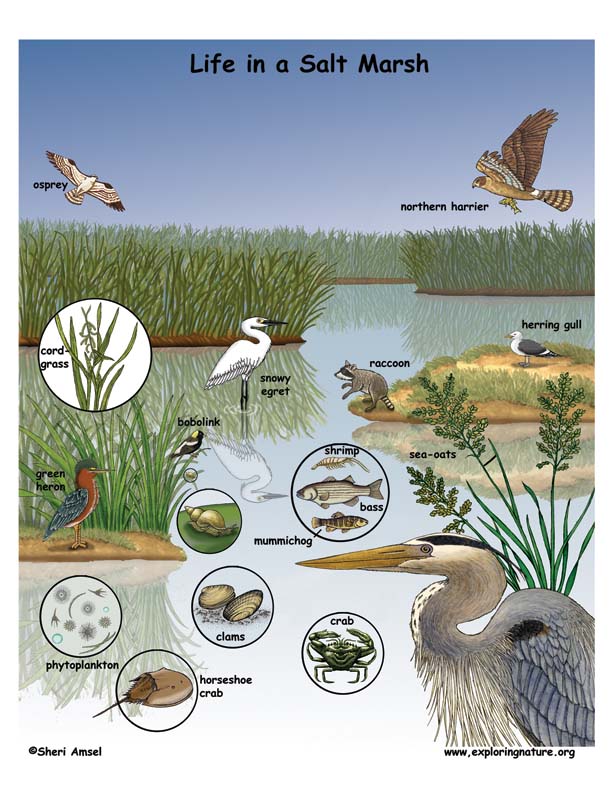

Salt marshes are found around the world where the ocean meets the land in sheltered intertidal zones like estuaries and inlets.
The water in a salt marsh is not as salty as the ocean, but not freshwater either. This in-between water is called brackish. The plants (and animals) that live there are tolerant of salt. This is called halophytic. Salt marshes are important for many of the same reasons that are all coastal wetlands.
Salt marshes are different from inland marshes in more ways than their salt content. They also experience a change in water levels throughout the day as the tides rise and fall. The salt marshes' intertidal zones can be broken down into three distinct areas - the mud flat, low marsh, and high marsh.
The mudflats (or creekbed marsh) are closest to the water and are the saltiest areas. They are only exposed during low tide when birds like egrets, herons, sandpipers and gulls and mammals like raccoons will hunt for animals burrowed in the mud. These include invertebrates like fiddler crabs, snails, clams and worms.
The low marsh (or lower marsh) spends part of the day underwater and part exposed. It grows tall, dense, tough vegetation called smooth cord grass (Spartina alterniflora) that can tolerate high salt levels by secreting excess salt. Cord grass prevents erosion and provides shelter for many animals (shrimp, fish and crabs) and an anchor for some (mussels and other invertebrates). In turn, the small invertebrates fertilize the grass and aerate its roots.
The high marsh (or upper marsh) is only underwater during the highest tides each month. This is the least salty area of the salt marsh, so has more types of plants in addition to cord grasses, like salt hay, spike grass, shore grass, shrubberies, sedges and rushes. Birds of prey like osprey and northern harriers fly low over the salt marsh to hunt.
Like many wetlands, salt marshes were once thought to be wastelands and were "reclaimed" for use as grazing land or development. It is thought that as much as half the salt marshes in the U.S. were filled in during the 1950s-70s. Through the Clean Water Act, Tidal Wetland Act and other legislation, salt marshes and other coastal wetlands have more protection than ever before. Yet, with more and more people living and doing recreation along the coasts, coastal habitats will always come under pressure from humans.
_____________________________________________________________________________________________________________
Related Activity:
Salt Marsh Coloring Page
Related Testing and Assessment:
Salt Marsh Labeling Page
_____________________________________________________________________________________________________________
When you research information you must cite the reference. Citing for websites is different from citing from books, magazines and periodicals. The style of citing shown here is from the MLA Style Citations (Modern Language Association).
When citing a WEBSITE the general format is as follows.
Author Last Name, First Name(s). "Title: Subtitle of Part of Web Page, if appropriate." Title: Subtitle: Section of Page if appropriate. Sponsoring/Publishing Agency, If Given. Additional significant descriptive information. Date of Electronic Publication or other Date, such as Last Updated. Day Month Year of access < URL >.
Amsel, Sheri. "Salt Marshes" Exploring Nature Educational Resource ©2005-2024. December 13, 2024
< http://www.exploringnature.org/db/view/Salt-Marshes >
